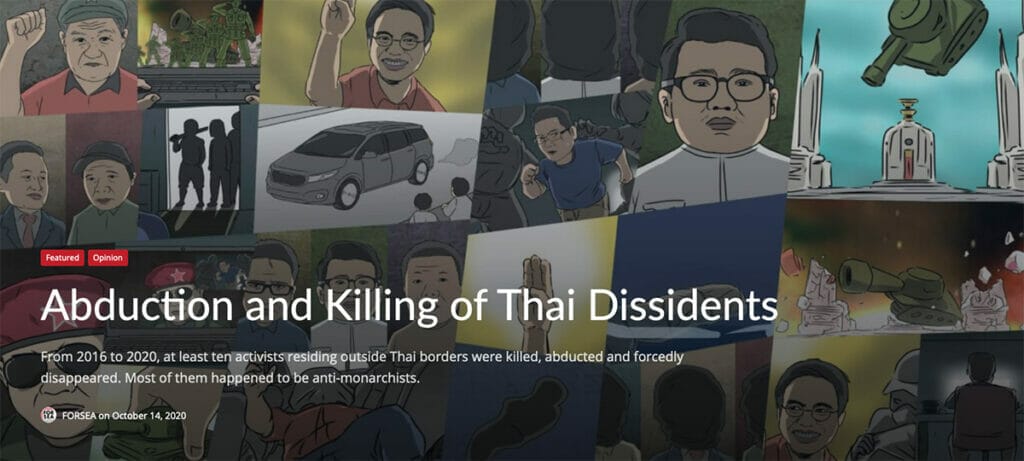The crackdown on Thai protesters at dawn on October 15 brought an abrupt end to overnight demonstrations focused on constitutional reforms and the military, which witnessed violent clashes and the disruption of the royal motorcade. The protests and counterprotests heightened the tension on both sides of the increasingly polarized and dangerous political divide in Thailand. The government announced a state of emergency in Bangkok, exercising absolute control over civil liberty. For now, assembly in public with more than five people is illegal, though protesters continue to flout these restrictions.
At the crackdown on October 15, the government employed security forces to disperse the crowds. Core leaders of the protests were detained, including the lawyer-turns-activist Anon Numpa, raising the question whether these arrests could serve to abort future protests.
Early in the protest, an organized group of yellow shirts, or royalist, counterprotests moved toward the protesters near the Democracy Monument and set about systematically provoking the pro-democracy protesters. This led to violent confrontations. Moreover, several hundred state officials, clad in yellow t-shirts with blue scarves, were seemingly deployed at the protest venue, in an attempt to provide a counterweight to the demonstrators for reform. Their closely cropped haircuts and yellow costumes signified that these state officials likely were part of groups of royal volunteers technically helmed by King Vajiralongkorn.
The peak of the protest was reached when a royal motorcade transporting Queen Suthida cut through the wave of demonstrators, alerting the authorities of her security in the midst of angry crowds. Surprised that the route of the motorcade had taken this direction, instead of avoiding demonstrations, the protesters took the opportunity to yell at the Queen, “Our tax! Our tax! Our tax!”—suggesting anger that Thai taxes were being used to pay for the royal family’s lavish lifestyle. This was the first time, since the end of the absolute monarchy, that the revered royal family had received such hostile treatment from demonstrators, in such a public way. The protesters confronted the motorcade even though the Thai monarchy is protected under the draconian lèse-majesté law, which forbids any insults towards the king and queen.
 The state of emergency has left no casualties, as protesters were agreeable in terminating their activities. Yet the position of the government right from the start of protests was firm; there would be no compromise. This position suggests that, if demonstrations continue in Thailand, in violation of the ban, a tougher crackdown could be coming. Last Friday, according to the New York Times, authorities “sprayed demonstrators with water cannons and sent rows of riot police officers at them, forcing a retreat. More than 20 protest leaders have been arrested.” Two of the protest leaders were charged on Friday in a manner that could potentially result in their being imprisoned for life.
The state of emergency has left no casualties, as protesters were agreeable in terminating their activities. Yet the position of the government right from the start of protests was firm; there would be no compromise. This position suggests that, if demonstrations continue in Thailand, in violation of the ban, a tougher crackdown could be coming. Last Friday, according to the New York Times, authorities “sprayed demonstrators with water cannons and sent rows of riot police officers at them, forcing a retreat. More than 20 protest leaders have been arrested.” Two of the protest leaders were charged on Friday in a manner that could potentially result in their being imprisoned for life.
Yet again over the weekend, protesters continued to mass in Bangkok, defying the ban. Indeed, protests spread to other parts of the country, suggesting they are unlikely to die out on their own any time soon. By organizing on social media and in other ways harder for the authorities to track, the protesters have been able to continue rallying.
King Vajiralongkorn has stayed silent through this series of protests, even as demonstrators demand monarchical reform. The silence of the king could be read like a silent order that he wishes the authorities to deal harshly with the demonstrations, and has no interest in directly interacting with the protestors and hearing their complaints. And now that core leaders of the protests are in custody, the authorities are ramping up their suppression of demonstrators, and the possibility of life imprisonment has been mooted, it seems hard to imagine where this movement goes from here.
Some protesters had counted on the pro-democracy oppositions parties in the country to take their demand forward for serious parliamentary debate about reforms. It is evident, however, that these parties fear the repercussions of such action. They do not want to be perceived as anti-monarchists and are unlikely to bring such discussions to the floor of parliament.
Pavin Chachavalpongpun
This article, dated October 19, 2020, is republished from the Asia Unbound blog from the Council of Foreign Relations.
Banner: October 16, 2020, Bangkok. Thousands of democracy protesters seized an intersection. Police used crowd control and high-pressure water tanks to seize back ground from protesters. kan Sangtong / Shutterstock.com

